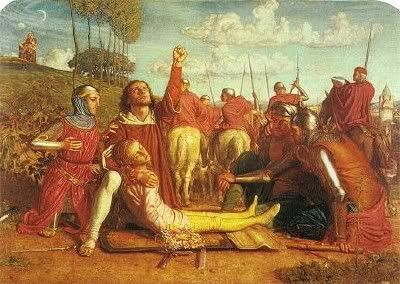
Last week I wrote a post about the Pre-Raphaelite that led to some questions about the original Pre-Raphaelite Brotherhood. I thought today I would write a little bit about the founding members of the PRB, and the major players among them.
Although there were seven original members of the Pre-Raphaelite Brotherhood, the founding members of the Brotherhood were really Dante Gabriel Rossetti, William Holman Hunt and John Everett Millais. These three have had the most lasting influence from among the original seven, and there work is the best known. After the idea for the PRB had been developed by Rossetti, Hunt and Millais, Rossetti invited his brother William, a clerk at the Inland Revenue Office, into the group as well. Interestingly, at the time the the Brotherhood was founded, William was neither a painter nor a serious writer. Nevertheless, he was the founding member's brother, and I suppose you can't blame Rossetti for wanting to include his family members!(Christina Rossetti was also an important part of the group, though she was excluded from the Brotherhood by reason of her sex).
Thomas Woolner, the fifth member of the PRB, was a sculptor who was introduced to the Brotherhood by D.G. Rossetti. In his biography of Rossetti, Evelyn Waugh is anxious to point out that Thomas Woolner married a Waugh (Alice Waugh). So too, did William Holman Hunt--twice. He first married Fanny Waugh, and when she died in childbirth, he married her sister, Edith. This was illegal in Britain at the time and he had to travel abroad in order to marry her!(Waugh, 35). No wonder Waugh was so interested in the Pre-Raphaelites!
James Collinson, a convert to Roman Catholicism had torrid on again/off-again relationships with both Christina Rossetti and the Catholic Church--both of which often seemed to hold far more interest to him than his painting--was the next to join. Frederick George Stephens was the seventh and final member of the original group. Stephens was a student of William Holman Hunt and his membership in the Brotherhood may have been due as much to Rossetti's superstition (a desire for a perfect seven-member group) as to any supposed artistic contribution from Stephens.
Source consulted: Evelyn Waugh. Rossetti, His Life and Works. London: The Folcraft Press, 1969.
Image: William Holman Hunt, Rienzi Vowing to Obtain Justice
Tuesday, September 23, 2008
The Original Members of the Pre Raphaelite Brotherhood
Posted by
Margaret
at
4:58 PM
![]()
![]()
Labels: millais, pre-raphaelites, rossetti, william holman hunt
Subscribe to:
Post Comments (Atom)


5 comments:
Hi Margaret, thanks for this. The group of seven, what is the significance of the number seven? Sorry to ask so many questions of you. I wonder if the Canadian version (Group of Seven) was influenced in the same way.
Good question, Stephen! I'll have to look into it!
I never thought about the significance of the number seven before. The Magnificent Seven, The Secret Seven, The Seven Sisters,The Seventh Son of the Seventh Son, all spring to mind.
Shame about excluding Christina don't you think?
Yes, what a shame for Christina! And the number seven is intriguing! Synchronicity or chance? (This seems to be the theme for me today!)
I love Hunt's "The Light of the World" of Christ knocking at the door. One of his copies is hanging in St. Paul's Cathedral. It's magnificent in person.
Rossetti was pretty superstitious, plus he and his father were both fascinated by secret societies, which probably helps to explain the obsession with having seven numbers.
It is a shame Christina couldn't be part of the group! She did write for their magazine, "The Germ", however.
Post a Comment